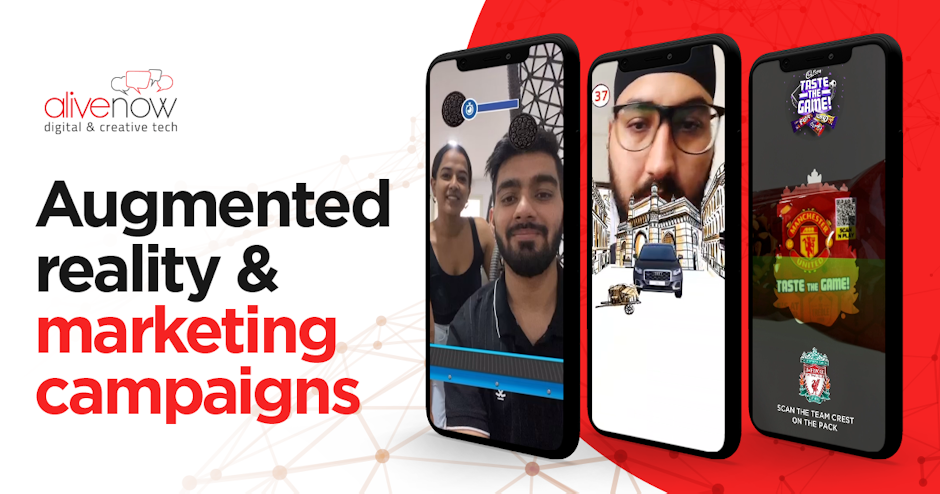9 reasons why augmented reality should be an integral part of marketing campaigns
Augmented reality has unparalleled and unique benefits that marketers just cannot ignore any more

1. Reach of Augmented Reality: 3.5 billion plus and counting
Smartphones are able to support AR almost effortlessly now. Approximately 3.8 billion phones globally have the ability to launch a web AR experience. Instagram and Snapchat's usage is only rising and AR has become an integral part of these apps. These numbers will only rise and smartphones are only getting more powerful to support AR experiences.
2. AR experiences deliver higher brand recall and increased purchase intent
Numerous studies from firms like Accenture, Statista, Snapchat and Facebook have shown that branded AR experiences result in higher brand recall and increased purchase intent. There's innovation, investment and interest in AR like never before. There's no better time to explore AR for your brand.
3. AR enables and simplifies user generated content like never before
Branded user generated content is equivalent to free advertising! Brands love it when users create content using branded filters and lenses. Platforms like Instagram, Snapchat and TikTok have made it extremely easy to create short video content using filters and lenses.
4. No better way to let customers "try before you buy"
At least right now, augmented reality is the only way you can let customers try before you buy. It's possible there may be other disruptive technologies in the future that might be able to do this better, but currently AR is the only way customers can try before they buy. AR enables product try on and product visualization like never before for widespread categories like cosmetics/make up, glasses/eyewear, watches, shoes/footwear, jewelry and facial accessories, furniture, automobile (interiors/exteriors) and in early stages for full body try-ons with full body tracking capabilities.
5. With AR: Voice + Gestures like blink, open mouth, move your hands, etc. Without AR: Click, tap, swipe
One major factor driving usage of AR filters and lenses is the fact that user's can interact using gestures like blinking, nodding their head, moving their hands/faces and voice. You can't ask for a more engaged user than this! Full screen take over + maximum possible attention from the user + gesture based interaction = fantastic engagement. I think anyone would prefer this over normal clicks, taps and swipes. At least for now, AR is the only way to unlock gesture-based messaging and advertising.
6. Augmented reality and the marketing funnel
If you think AR isn't the right fit for a certain brief, you may be wrong. AR can be used for almost any marketing campaign. We've seen AR used for product launches, store launches, festive seasons, social activism, political activism, to drive sales, engagement, lead generation, pique interest and much more.
7. AR is Immersive: Ability to do more with AR & 3D vs flat UI & 2D
Tap to place the product and walk around it, scale the product to see it's real size, shoot aliens hidden in your room, try on shoes, lipsticks, eyelashes, glasses, hats, change your floor, change colors of products in 3D - All possible with 3D and augmented reality. Not possible in a flat UI! Bottom line is there's tons more you can do with AR and 3D.
8. Hyper-casual gaming is way more fun in AR
We know from the many campaigns we've executed that AR games are some of the best performing ones. On both Snapchat and Instagram, brands have the ability to create immersive and fun AR gaming experiences that users can play and challenge friends. AR games unlocks the possibility of having gesture controlled games, enables brands to launch 2 or 3 player games and gives users the ability to easily challenge friends by tagging them on stories. We know from our data that AR games perform exceedingly well as those filters have a higher dwell time with users replaying these games to beat their own scores!
9. It costs less, it's faster to build, and there's a great community to help!
This might seem irrelevant but is extremely important. 5-7 years ago, every aspect of creating an augmented reality experience was harder and more expensive. Whether it's creating 3D models or hiring an AR engineer or deploying an AR experience it was just a bit more cumbersome and discouraging. Not any more. There are more tools, more resources, more platforms, more support, more documentation and overall a lot more people and companies that are simplifying and lowering the cost of bringing AR to life.
Over the next few months and years the capabilities of AR will only increase. There's no better time to start planning and thinking about how augmented reality should become an integral part of your marketing and communications strategy.
